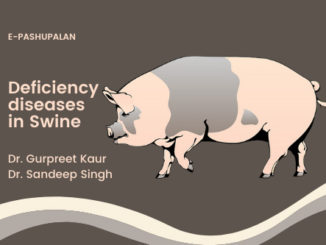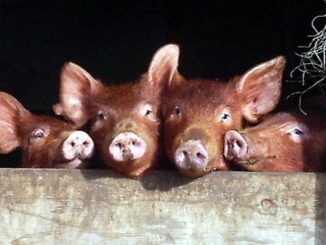Introduction
Commercial pig farming in India for meat production is yet to flare up. Also, it is one of the best and profitable business ideas for entrepreneurs. People are looking forward to adopt pig farming as it has many advantages over other livestock farming. There are several highly meat producing pig breeds available around the world. Some are very well suited for commercial meat production in India.

Recommended mostly for
- Small and landless farmer
- Young entrepreneurs opting for agriculture as occupation can have pig farming as subsidiary occupation.
- Uneducated youth
Advantage of Pig farming
- Pig has highest feed conversion efficiency. They produce more live weight gain from a given weight of feed than any other class of meat producing animals.
- They are prolific breeders with short gestation period (3 month 3 weeks 3 days). Each sow produces 6-12 piglets in each farrowing.
- Pig farming requires small investment on building and equipment.
- Pigs are known for their meat yield. Dressing percentage ranges from 65 to 80% in comparison to other livestock species whose dressing percentage may not exceed 65%.
- Pig manure is widely used as fertilizers for crop farming, fish ponds, and so pig farming provides an opportunity to integrate animal farming with poultry cum fish cultures.
- Pig fat is used in soap industry, paint and other chemical industry.
- Bacon, ham, sausages produced by the pigs are relished by tribal people and it is widely utilized in many parts of the world.
How to start pig farming?
There are some description for those people who want to start pig farming:
Select a suitable land
- It is a very important and first step for starting pig farming in India.
- Make sure that the place is away from the urban city
- Ensure availability of sufficient amount of clean water as well as electricity.
- Presence of suitable market near the farm area will be useful to market the pork.
- Good transportation facilities should be available.
Buy productive pig breeds
Most of the pig farmers of our country are raising low productive small sized indigenous non-descriptive breeds of pigs. Subsequently, they are not getting desired production. Large White Yorkshire is the most extensively used exotic breed in India.
Selection of commercial pig breeds
- Feed efficiency and fertility are most important factors that influence the success rate of commercial pig farming. It is better to take consult veterinary professionals at the time breed selection.
- Select gilts from sows which have consistently farrowed and weaned large litters.
- The boar (male breeder pig) should be selected from females which have consistently farrowed and weaned high litters.
The most important factors to be considered for selecting breeding stocks of pigs are
- Litter size of pigs
- Strength and vigour of litters
- Milking ability of sows
- Temperament of pigs
Housing of Pigs
- Adequate housing and equipment are essential for successful pig farming.
- Housing not only provide shelter, but also keep them safe from inclement weather, parasite, and various types of pig diseases.
- Make proper ventilation system
- Different age groups of pigs should not be kept together.
- Wallowing tank: Pigs are more sensitive to high temperature due to presence of less sweat glands, and are unable to dissipate excess heat. Therefore, wallowing tank are used for cooling the pigs. It should be of 2.5m length and 1.2m width
- The space requirement for different categories of pig is as follows
| Type of animal | Feeding space | Cover area | Open area | Maximum number of pigs housed |
| Weaned pig | 20-30 | 0.9-1.8 | 0.9-1.8 | 30 |
| Gilt | 30-40 | 1.8-2.7 | 1.8-2.0 | 6-7 |
| Farrowing sow | 75-100 | 7.5-9.0 | 8.8-12.0 | 1 |
| Boar | 65-75 | 6.5-7.5 | 8.8-12.0 | 1 |
Feeding management
- The productivity of pig depends on the feed which they consume. Growth production and animal health are correlated with feeding habits.
- The basic ingredients of pig feed are oat, maize, grains, wheat, rice, sorghum, and other millets.
- To meet protein requirements, it should be fed with oilcakes and fishmeal.
- Mineral supplements and vitamins should be added in the diet at appropriate levels
Feed requirement in commercial pig farming based on weight
|
Weight of pigs |
Consumption of feed/pig/day |
|
25 50 100 150 200 250 |
2 kg to 2.5 kg 3.25 kg to 3.5kg 5.3 kg to 5.5 kg 6.8 kg to 7.2 kg 7.5 kg to 8.0 kg 6.3 kg to 8.6 kg |
Breeding management
- Both male and female pig become suitable for breeding within 8 months of age
- They reach 110 to 120 kg body weight at the end of 8th
- The heat period of female pig lengths for 2 to 3 days.
- Sow become suitable for breeding again after 2 to 10 days after weaning.
- Best time for breeding: first day for gilts and second day for sows.
- Period of oestrous cycle: 21 days
- Gestation period: 114 to 118 days
- Removal of needle tooth to avoid injury to the udder.
- Anaemia is most common in new piglets. Iron dextran must be given at initial stages
- Raising orphan piglets in order to feed the piglet whose dam has died for various reasons.
- Castration may be done at 3 to 4 weeks of age
- Weaning of piglets should be done at 8 weeks of age.
- New born piglets should be vaccinated against swine fever at the age of 60 days.
- The smallest and weak piglet in a litter is called RUNT. It should be properly taken care at the initial state to avoid death
Marketing of pigs
Once pigs reached marketable weight, we can sell them to slaughter houses and wholesale livestock dealers. The commercial pig farming does not require extensive marketing as pork has excellent demand. They can be sold at the farm gate.






Be the first to comment